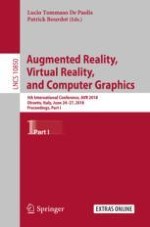2018 | Book
Augmented Reality, Virtual Reality, and Computer Graphics
5th International Conference, AVR 2018, Otranto, Italy, June 24–27, 2018, Proceedings, Part I
Editors: Lucio Tommaso De Paolis, Patrick Bourdot
Publisher: Springer International Publishing
Book Series : Lecture Notes in Computer Science
